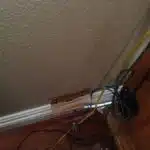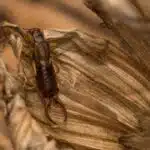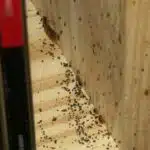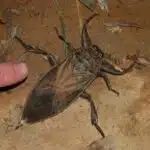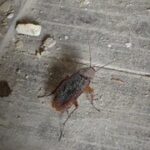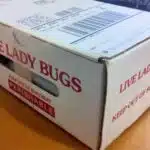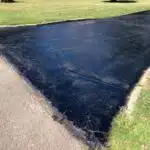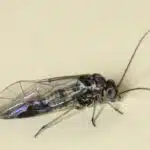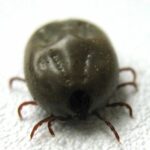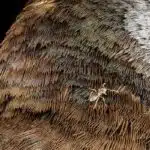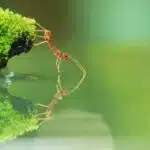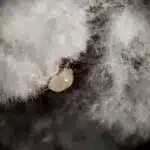Ladybugs are a common type of beetle that can often be found inside homes. While these insects are generally considered harmless and even beneficial, they can become a nuisance when they start to infest living spaces. Ladybug infestations usually occur in the fall or winter months when the weather turns cooler, and the bugs seek warmth indoors. In this article, we will discuss how to get rid of ladybugs inside your home by exploring their behavior patterns and identifying effective pest control methods.
As an entomologist or pest control specialist, it’s important to understand the behavior of ladybugs so that we can effectively eliminate them from our client’s homes. Ladybugs are attracted to light-colored surfaces, especially white or yellow ones. They also prefer warm areas with high humidity levels. Once they have found a suitable location, they release pheromones that attract other ladybugs to join them. This is why ladybug infestations tend to grow quickly and can become difficult to manage without professional help. However, by taking proactive steps such as sealing cracks and gaps around windows and doors and using insecticides, homeowners can successfully rid their homes of ladybugs and prevent future infestations.
Understanding Ladybug Behavior
Ladybugs, also known as lady beetles or ladybird beetles, are small insects belonging to the family Coccinellidae. They are commonly found in gardens and fields, feeding on aphids and other plant-eating insects. Ladybugs have become a popular insect for homeowners because of their bright colors and perceived benefits for gardens. However, when they infest homes, they can become a nuisance.
Ladybug mating habits vary depending on the species. Some species mate once a year, while others mate multiple times throughout the season. Ladybugs typically lay their eggs in clusters on the undersides of leaves in vegetation, and the larvae emerge after about a week. The larvae go through several stages before pupating and turning into adults. Adult ladybugs can live up to two years.
Ladybug color variations can range from red with black spots to black with red spots, and some species have no spots at all. The bright colors serve as a warning to predators that they are toxic or distasteful when eaten. Some species of ladybugs can secrete a foul-smelling liquid from their legs when threatened by predators or humans handling them roughly. Understanding these behaviors can help in identifying and controlling an infestation of ladybugs inside the home.
Knowing how ladybugs behave is just one step in identifying if there is an infestation present within your home.
Identifying Ladybug Infestations
Ladybugs, also known as lady beetles or ladybirds, are fascinating insects known for their vibrant colors and cute appearance. Although they are generally harmless and even beneficial to gardens and crops, they can become a nuisance when they invade homes in large numbers. Understanding ladybug behavior is crucial to getting rid of them effectively.
Ladybugs are attracted to warmth and light, which makes them more likely to enter homes during the fall and winter months. They typically seek shelter in cracks, crevices, and other hidden spots where they can hibernate until spring. Ladybug habitats include trees, shrubs, grasses, and other vegetation where aphids, their primary food source, are plentiful.
Identifying ladybug infestations is the first step towards controlling them. Signs of infestation may include the presence of live or dead ladybugs inside the home, as well as stains or odors caused by their excrement. In some cases, ladybugs may also bite humans or pets if they feel threatened or disturbed. To prevent infestations from occurring in the first place, it is important to seal all cracks and gaps around doors, windows, vents, and pipes that could serve as entry points for these insects.
Ladybugs may seem harmless at first glance but can quickly become a nuisance when they invade homes in large numbers. By understanding their behavior and habitats, homeowners can take proactive measures to prevent infestations from occurring. In the next section about ‘why ladybugs enter homes’, we will discuss some of the common reasons why these insects seek shelter indoors and what homeowners can do to keep them out.
Why Ladybugs Enter Homes
Ladybugs are attracted to warmth, and as such homes with a consistent temperature can attract them. Ladybugs may also be seeking food sources such as aphids or other small insects that may be found in homes. Ladybugs may enter through small openings in the home’s exterior, or may even be brought in on clothing or groceries unknowingly. It is important to take preventative measures to ensure ladybugs do not enter the home, such as ensuring all exterior openings are sealed and inspecting clothing and groceries when coming into the home.
Attraction To Warmth
Ladybugs are known to enter homes during the winter months, seeking refuge from the cold weather outside. The heating preferences of these bugs lead them towards areas with a consistent source of warmth, such as houses and buildings that provide shelter and heat. Ladybugs have been observed to congregate in large numbers around windowsills, attics, and other areas where sunlight can be found.
Their winter behavior is partly attributed to their limited mobility in low temperatures, as well as their reliance on hibernation to survive the season. However, it’s important to note that not all ladybugs are attracted to warmth equally. Some species may prefer cooler temperatures and seek out shelter in natural environments such as tree bark or leaf litter.
To prevent an infestation of ladybugs in your home, it’s recommended to seal any cracks or gaps where they can enter from the outside. Additionally, reducing heat sources near windows and doors can discourage them from congregating in those areas. By understanding the heating preferences and winter behavior of ladybugs, homeowners can take proactive measures to keep these pests out of their homes without resorting to harmful pesticides or chemicals.
Seeking Food Sources
Ladybugs are known to enter homes for various reasons, including seeking refuge from cold weather and searching for food sources. Ladybugs are omnivores, and their food preferences include aphids, mites, and other small insects. They are considered beneficial insects in gardens and farms as they help control pests that damage crops.
However, when ladybugs enter homes in search of food, they can become a nuisance and cause minor disturbances. Some homeowners may resort to harmful pesticides or chemicals to eliminate these pests, but there are alternative remedies that can be used instead. For example, sealing cracks and gaps where ladybugs can enter the home can help prevent infestations. Additionally, reducing the presence of their preferred food sources near the home can discourage them from entering.
It’s important to note that not all species of ladybugs have the same food preferences or behaviors. Some may even prefer plant-based diets and seek out pollen or nectar as their primary source of nutrition. Understanding the feeding habits and preferences of ladybugs can help homeowners take proactive measures to keep them out of their homes while still preserving their beneficial role in natural environments.
Prevention Strategies
Prevention Strategies:
Ladybugs can be a nuisance when they invade your home. The good news is that you can prevent them from entering your home in the first place. Outdoor prevention involves taking measures to keep ladybugs away from your home. This includes trimming trees and bushes that touch the exterior walls of your home, sealing cracks and gaps, and using insecticides around the perimeter of your home.
Indoor prevention strategies focus on keeping ladybugs out of your living spaces once they have made it past the perimeter. One effective way to do this is by using screens on windows and doors to keep them from entering through those openings. Ladybugs are also attracted to moisture, so it is important to fix any leaks or water damage in your home as soon as possible.
In addition to these strategies, it is important to regularly clean and vacuum your home to remove any existing ladybugs. By taking these preventative measures, you can significantly reduce the likelihood of a ladybug infestation in your home. The next step in preventing ladybugs from invading your living spaces is sealing cracks and gaps.
Sealing Cracks And Gaps
Cracks and gaps in walls, ceilings and other areas of a home are common entry points for various insects, including ladybugs. It is important to locate and inspect these entry points in order to determine the extent of the infestation and to plan for treatments. Caulking is an effective method for sealing cracks and gaps to prevent further infestations, and caulk guns can be used to apply the material. In addition to caulking, other measures such as screens, weather stripping, and other physical barriers can be used to prevent further infestations. To ensure long-term effectiveness, it is important to regularly inspect the property and make sure that the caulking and other barriers remain intact and free of damage. Finally, it is important to remove any existing infestations before sealing the cracks and gaps, as this will reduce the chances of re-infestation.
Finding And Locating Cracks And Gaps
It can be frustrating to see ladybugs inside your home, especially when you’re trying to relax. Identifying entry points, however, is an important step in preventing them from entering in the first place. As entomologists or pest control specialists, we suggest inspecting your home’s walls and foundation for cracks and gaps that may serve as entry points.
Locating these openings can be tricky, but it’s crucial to seal them off. Ladybugs are tiny insects that can fit through even the smallest gaps or crevices. Sealing gaps and cracks around windows, doors, pipes, and electrical outlets with silicone caulk or expanding foam can help prevent ladybugs from entering your home.
It’s important to note that sealing cracks and gaps is not a one-time fix. Regularly inspecting your home for new entry points and sealing them promptly can help keep ladybugs outside where they belong. By taking these preventative measures, you’ll be able to enjoy a ladybug-free living space without having to worry about their presence disrupting your peace of mind.
Sealing Cracks And Gaps Using Caulking And Caulk Guns
As entomologists or pest control specialists, we understand the importance of sealing cracks and gaps to prevent ladybugs from entering your home. One effective way to seal these openings is through caulking techniques using a caulk gun. This DIY sealing method involves applying a thin layer of silicone caulk along the edges of windows, doors, pipes, and other areas where ladybugs may enter.
Before caulking, it’s crucial to thoroughly clean the area to be sealed. Any debris or dirt can compromise the effectiveness of the seal. Once cleaned, apply a continuous bead of caulk along the gap or crack while steadily moving the caulk gun. Use your finger or a tool to smooth out any excess caulk and ensure proper adhesion.
While sealing cracks and gaps with caulking may seem like a small task, it can make a significant impact in keeping ladybugs out of your home. Regularly inspecting for new entry points and promptly sealing them off will help keep your living space free from unwanted pests. By taking these preventative measures, you can ensure that your home remains a comfortable and peaceful environment for you and your family.
Preventing Further Infestations
After sealing cracks and gaps in your home, it’s important to take further steps to prevent future ladybug infestations. While caulking can provide an effective barrier against these pests, DIY ladybug repellents can also be used as a long term prevention technique. These repellents are often made from natural ingredients such as citrus or peppermint oil, which deter ladybugs from entering your home.
Another way to prevent further infestations is through regularly cleaning and maintaining your living space. Ladybugs are attracted to areas with moisture and food sources such as crumbs or other debris. By frequently vacuuming, wiping down surfaces, and properly storing food, you can reduce the likelihood of attracting these pests.
Finally, it’s essential to identify any potential outdoor sources of ladybugs such as plants or trees near your home. By trimming back branches or removing plants that attract ladybugs, you can minimize their presence on your property. Taking these preventative measures alongside sealing cracks and gaps in your home will ensure that you have a pest-free environment for years to come.
Cleaning And Decluttering
Sealing cracks and gaps is a crucial step in preventing ladybugs from invading your home, but it is not enough to eliminate them completely. Ladybugs can still find their way into your home through open doors or windows, so it’s important to take additional measures to get rid of them. Cleaning and decluttering are essential in controlling ladybug populations inside your home.
Decluttering tips: Ladybugs are attracted to cluttered areas where they can hide and breed. To prevent this, make sure to regularly clean and organize your home. Remove any unnecessary items that may serve as hiding places for ladybugs. Keep clothes, linens, and other fabrics in sealed containers or bags to avoid attracting these pests.
Cleaning techniques: Keeping a clean house is key in preventing ladybugs from invading your space. Use a vacuum cleaner with a hose attachment to remove any ladybugs that may have found their way into your home. Make sure to thoroughly clean all surfaces with soap and water, especially around windows and doors where ladybugs tend to congregate.
It’s important to note that chemical insecticides should be used as a last resort after all other methods have been exhausted. Using insecticides can be harmful not only to the environment but also to humans and pets if not used properly. In the next section, we will discuss using insecticides safely and effectively in getting rid of ladybugs inside your home.
Using Insecticides
Choosing effective insecticides is crucial in getting rid of ladybugs inside your home. Insecticides are specifically designed to target and eliminate unwanted pests, including ladybugs. There are various types of insecticides available in the market, but not all of them are effective against ladybugs. Therefore, it is essential to choose the right insecticide that is formulated to kill ladybugs.
When using insecticides, it is critical to take safety precautions seriously. Insecticides contain chemicals that can be harmful if ingested or inhaled in large amounts. Always read the label and follow the instructions carefully before using any insecticide. Wear protective gear such as gloves and masks to prevent exposure to the chemicals, especially if you have a history of allergies or respiratory problems.
Insecticides can be an effective way to get rid of ladybugs inside your home. However, it is important to use them with caution and follow safety guidelines when applying them. With proper use, these chemical treatments can help eliminate a ladybug infestation quickly and efficiently.
| Type of Insecticide | How it Works | Pros | Cons |
|---|---|---|---|
| Pyrethroids | Attacks the nervous system of insects causing paralysis and death | Fast-acting; kills on contact; low toxicity to mammals | Can harm aquatic life; some insects may develop resistance over time |
| Neonicotinoids | Interferes with the transmission of nerve impulses in insects leading to paralysis and death | Easy application; long-lasting effect; low toxicity towards mammals | Can harm beneficial insects like honeybees; high water solubility leads to leaching into groundwater |
| Organophosphates (OPs) | Disrupts enzyme activity leading to paralysis and death | Effective against a wide range of insects; relatively inexpensive | High potential for human exposure through skin contact or inhalation; highly toxic towards mammals |
The table above provides a comparison between three commonly used types of insecticides that are effective against ladybugs. It is important to note that while these insecticides can be effective, they also have their own set of pros and cons. Therefore, it is essential to weigh the options carefully before choosing an insecticide that works best for your situation.
Transitioning into the subsequent section discussing natural remedies, it is important to note that while insecticides may be effective in getting rid of ladybugs, they contain chemicals that can be harmful to humans and pets. For those who prefer a more natural approach, there are several alternatives available that are safer and eco-friendly.
Natural Remedies
Insecticides may be effective in getting rid of ladybugs, but some people may be wary of using such chemicals in their homes. Fortunately, there are natural remedies that can also help to repel these insects. One option is herbal repellents, which can be made by mixing essential oils such as peppermint, clove, or eucalyptus with water and spraying the mixture around areas where ladybugs are present. These scents are known to deter ladybugs and may keep them away from your home.
Another natural way to get rid of ladybugs is by creating DIY traps. These traps can be made using materials found around the house and can effectively lure ladybugs away from living spaces. For example, a trap could be made using a plastic bottle with a funnel-shaped entrance hole cut into it. The bottle would then be filled with a mixture of water and dish soap, which will trap the bugs once they enter.
While herbal repellents and DIY traps can help reduce the number of ladybugs inside your home, it’s important to note that vacuuming is still one of the most effective methods for removing these insects. It’s recommended to use a handheld vacuum rather than a regular floor vacuum to avoid squishing them and spreading their odor throughout the room. Additionally, make sure to dispose of the bag or empty out the container outside immediately after use to prevent any escaped bugs from re-entering your home.
Vacuuming Ladybugs
Metaphorically speaking, ladybugs are like unwelcome guests that have overstayed their welcome. They may be cute and harmless, but nobody wants them inside their home. Vacuuming is a simple yet effective method to get rid of these pesky insects without causing harm to them.
When it comes to vacuuming ladybugs, there are some techniques you can follow to ensure success. Firstly, use a low-suction setting on your vacuum cleaner so that the ladybugs don’t get trapped in the hose or filter. Secondly, use an attachment tool such as a crevice tool or brush attachment to suck up the ladybugs from hard-to-reach areas like corners and crevices. Thirdly, make sure to keep your vacuum bag or container empty after each use.
After collecting the ladybugs in your vacuum cleaner, it’s important to dispose of them properly. One method is to release them outside in an area away from your home. Another option is to place them in a container with a lid and freeze them for several hours before disposing of them in the trash. Whatever method you choose, make sure it aligns with local regulations regarding pest disposal methods.
The next section will discuss another effective technique for getting rid of ladybugs: trapping. But before we move on, remember that prevention is key when it comes to keeping these unwelcome guests out of your home. Regularly sealing cracks and gaps around windows and doors can go a long way in preventing ladybug infestations from occurring in the first place.
Trapping Ladybugs
Ladybugs are a common household pest that can be difficult to remove. Effective strategies for trapping ladybugs involve the use of DIY traps such as plastic cups and tape, or more specialized traps that are commercially available. DIY traps are relatively simple to construct and are often a cost-effective solution for trapping ladybugs. Commercially available traps are more specialized and may involve the use of insecticides or other repellents to attract and capture ladybugs.
Trapping Ladybugs
Ladybugs can be a nuisance when they invade your home. One of the most effective ways to get rid of ladybugs is by trapping them. Trapping techniques are essential in controlling ladybug infestation, and it is vital to do so in a safe and humane way.
There are several trapping techniques that homeowners can use to control ladybugs. One such technique involves using a vacuum cleaner with a hose attachment. Place the hose near the ladybugs and suck them up into the vacuum cleaner. Be sure to dispose of the bag or container outside immediately after trapping them.
Another trapping technique involves using sticky traps specifically designed for ladybugs. These traps contain pheromones that attract ladybugs, making them stick to the trap’s surface. Once caught, it is essential to dispose of these traps properly by placing them in a sealed plastic bag and throwing them away.
In conclusion, trapping is an effective way of getting rid of indoor ladybug infestations without harming the insects or spreading harmful chemicals around your home. However, it is crucial to ensure that you dispose of trapped bugs safely and humanely to prevent further issues down the line. By following proper trapping techniques and safe disposal methods, you can successfully eliminate indoor ladybug populations from your home.
Diy Traps
Trapping ladybugs is a humane and effective way of getting rid of an indoor infestation. There are various techniques for trapping ladybugs, including using vacuum cleaners or sticky traps. However, some homeowners prefer to use DIY traps as a more affordable option. Homemade bait can be used to attract and trap ladybugs in a safe and humane manner.
One popular homemade bait that attracts ladybugs is a mixture of water and dish soap. The solution should be placed in a shallow dish near the area where the ladybugs are present. Ladybugs will be attracted to the scent of the soap and drown in the mixture. Another option is to use a combination of sugar, yeast, and water as bait. This mixture produces carbon dioxide, which attracts the insects into a container with an opening small enough for them to enter but not escape.
While commercial options are available for trapping ladybugs, DIY traps can be just as effective if done correctly. However, it is important to note that homemade traps may not last as long or be as durable as commercial options. Additionally, it is crucial to dispose of trapped insects properly to prevent further issues from arising. Overall, using homemade bait in DIY traps can provide homeowners with an affordable way to control indoor ladybug populations without causing harm to the insects or using harmful chemicals in their homes.
Professional Pest Control
Trapping ladybugs can be an effective method to remove them from your home, but it may not completely solve the problem. If you find yourself constantly dealing with these insects, it may be time to consider pest control options. There are various methods available for eliminating ladybugs, but the most efficient way is by hiring professionals.
Pest control options include chemical treatments and natural remedies such as diatomaceous earth or essential oils. However, it is important to note that some chemicals may harm other insects or animals in your home. Natural remedies may also not be as effective as chemical treatments, especially for severe infestations. Therefore, hiring professionals who have the expertise and knowledge to use safe and effective methods is recommended.
When hiring professionals for pest control, it is important to do research and choose a reputable company. Look for companies that use eco-friendly methods and have experience in dealing with ladybug infestations. They can provide a thorough inspection of your home and recommend the best treatment plan based on the severity of the infestation.
Ladybugs are beneficial insects that play an important role in our ecosystem, but they can become a nuisance when they invade our homes. Pest control options are available for those who cannot seem to get rid of them through trapping or natural remedies. Hiring professionals who use safe and effective methods is the most efficient way to eliminate ladybugs from your home without harming other insects or animals.
Transition: Understanding the life cycle of ladybugs is crucial in preventing future infestations.
Ladybug Life Cycle
Ladybugs are a delightful sight to behold. They are cute, vibrant, and seemingly harmless. However, their presence inside your home could be quite unsettling. Before we delve into how to get rid of them, it is important to understand the ladybug life cycle.
Ladybugs have an interesting anatomy that sets them apart from other insects. They have a hard exoskeleton that covers their wings and body, protecting them from predators. Their wings are located on their backs and fold neatly beneath the exoskeleton when not in use. Ladybugs also have powerful legs that allow them to move quickly and climb surfaces with ease.
When it comes to reproduction, ladybugs lay eggs on plants where aphids are present. The larvae hatch within a few days and begin feeding on the aphids until they reach maturity. Once fully grown, ladybugs mate and lay eggs, starting the cycle anew.
Understanding the intricacies of the ladybug life cycle can help us appreciate these insects even more. In the next section, we will explore their diet and habitat in order to gain a better understanding of their behavior and how to keep them out of our homes.
Ladybug Diet And Habitat
Ladybugs, also known as ladybirds, are small and colorful insects that belong to the Coccinellidae family. They are considered beneficial insects because they feed on crop pests such as aphids, mites, and scale insects. Ladybugs can also be found in gardens and forests where they feed on other small insects. Despite their usefulness, ladybugs can become a nuisance when they invade homes during the winter months.
Ladybug predators include birds, spiders, and some species of wasps. These predators rely on ladybugs as a food source which can result in reduced populations of ladybugs. Ladybugs have an oval-shaped body with a hard exoskeleton that protects them from predators. Their wings are located under their shell-like wings covers, which can be opened when flying.
In terms of habitat, ladybugs prefer to live in areas with ample vegetation such as forests and fields. They lay their eggs on plants that provide food for their larvae once they hatch. Ladybug larvae look different from adult ladybugs: they have long bodies with spiky protrusions and do not have wings yet. Understanding the diet and habitat of ladybugs is essential to keep them away from homes while still benefiting from their pest control abilities.
Furthermore, understanding the anatomy of ladybugs helps homeowners identify them correctly to avoid confusing them with other harmful pests such as Asian beetles or boxelder bugs that may resemble them in appearance but do not provide any benefits. In the next section, we will discuss the various benefits associated with ladybug infestations and how homeowners can harness these advantages without having to deal with an overwhelming number of these insects inside their homes.
Benefits Of Ladybugs
Ladybugs are often seen as cute and harmless insects. They have a distinctive red and black spotted exterior that is pleasing to the eye. However, ladybugs are not just beneficial for their aesthetic appeal; they also have ecological importance. Ladybugs are predators of many pests, including aphids, mites, and other small insects that can cause harm to plants. Thus, farmers and gardeners often appreciate the presence of ladybugs in their fields.
The benefits of ladybugs extend beyond crop protection. Ladybugs also play a crucial role in pollination. Though they are not as efficient as bees or butterflies, ladybugs help with cross-pollination by visiting flowers in search of food. This process ensures that plants produce healthy fruits and seeds which serve as food for other animals.
In summary, ladybugs offer numerous benefits to both humans and the environment. Their predatory behavior helps control pest populations while their role in pollination aids in plant reproduction. It is essential to recognize the ecological importance of these insects as we continue to work towards maintaining a healthy ecosystem.
Conclusion And Final Thoughts
Ladybugs can be a nuisance to homeowners when they invade their living spaces. While they are not harmful to humans, ladybugs can leave behind a pungent odor and stains on walls and fabrics. In this article, we have explored several effective methods for removing ladybugs from your home.
Firstly, sealing off entry points is an essential step to prevent future infestations. Ladybugs can enter through cracks in windows, doors, and siding. Be sure to inspect your home regularly and seal off any potential entry points with caulk or weather stripping.
Secondly, vacuuming up the ladybugs and disposing of them outside is a quick and easy way to remove them from your home. Be sure to use a vacuum with a filter as ladybugs release an orange-colored secretion that can clog the vacuum’s filter.
Lastly, you can use insecticides specifically designed for ladybug control. However, it is important to note that these chemicals may also harm beneficial insects like bees and butterflies. Therefore, it is crucial to follow the instructions carefully and consider the environmental impact before using insecticides.
In conclusion, there are several effective ways to get rid of ladybugs inside your home. However, prevention measures are crucial in avoiding future infestations. It is also important to consider the environmental impact before using harsh chemical pesticides. By following these tips, you can safely remove ladybugs from your home without harming yourself or the environment.
Conclusion
Ladybugs can be a beneficial insect to have in your garden as they feed on aphids, but when they make their way into your home, it can become frustrating and overwhelming. Understanding ladybug behavior and identifying infestations are the first steps to effectively getting rid of them. Prevention strategies such as sealing cracks and gaps can also be helpful in keeping ladybugs out.
It is important to note that ladybugs serve an important role in the ecosystem and should not be exterminated without reason. Instead, consider using natural deterrents or simply removing them manually with a vacuum or dustpan. Ladybugs may seem like a nuisance inside your home, but they are actually fascinating insects with a unique life cycle and diet.
In conclusion, while ladybugs may seem like an unwelcome guest in your home, it is important to remember their positive impact in the outdoor environment. As entomologists or pest control specialists, we must approach the issue of indoor ladybug infestations with care and consideration for these valuable insects. With proper identification, prevention strategies, and humane removal methods, it is possible to coexist with ladybugs in a way that benefits both humans and nature. As the saying goes, “don’t throw out the baby with the bathwater” – let’s appreciate these colorful beetles for what they are and find ways to live alongside them peacefully.
Image Credits
- “Ladybug bento box” by cuteobento (featured)




